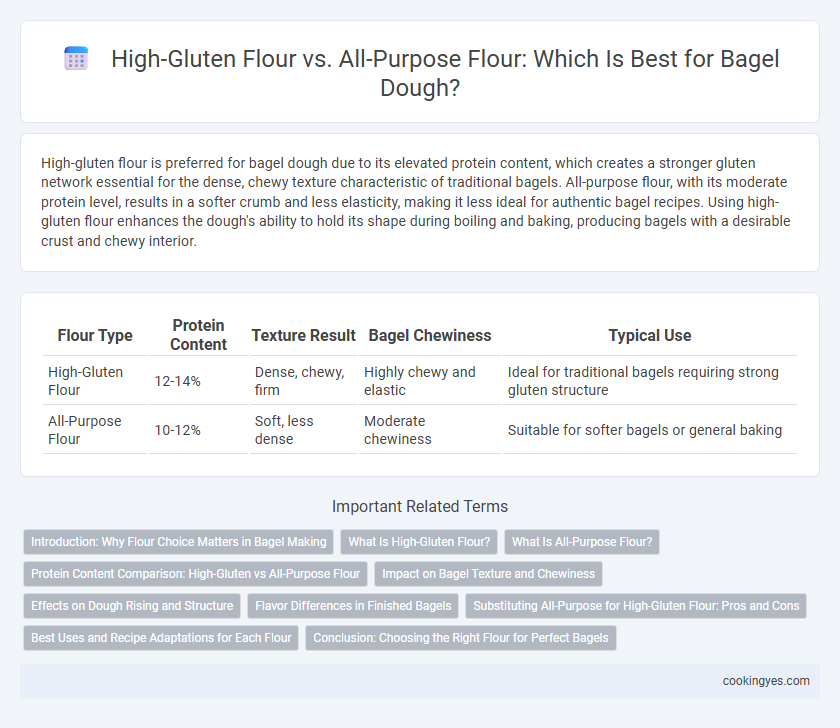High-gluten flour is preferred for bagel dough due to its elevated protein content, which creates a stronger gluten network essential for the dense, chewy texture characteristic of traditional bagels. All-purpose flour, with its moderate protein level, results in a softer crumb and less elasticity, making it less ideal for authentic bagel recipes. Using high-gluten flour enhances the dough's ability to hold its shape during boiling and baking, producing bagels with a desirable crust and chewy interior.
Table of Comparison
| Flour Type | Protein Content | Texture Result | Bagel Chewiness | Typical Use |
|---|---|---|---|---|
| High-Gluten Flour | 12-14% | Dense, chewy, firm | Highly chewy and elastic | Ideal for traditional bagels requiring strong gluten structure |
| All-Purpose Flour | 10-12% | Soft, less dense | Moderate chewiness | Suitable for softer bagels or general baking |
Introduction: Why Flour Choice Matters in Bagel Making
High-gluten flour, with its protein content typically ranging from 12-14%, creates a stronger gluten network essential for the chewiness and structure characteristic of authentic bagels. All-purpose flour, containing around 10-12% protein, results in a softer, less elastic dough that may yield bagels with a fluffier texture but lack the traditional dense bite. Selecting the right flour directly influences the texture, rise, and chew, making flour choice fundamental to achieving classic bagel quality.
What Is High-Gluten Flour?
High-gluten flour is a type of wheat flour with a protein content typically around 13-14%, significantly higher than all-purpose flour's 10-12%. This elevated protein level contributes to stronger gluten development, which provides bagel dough with its characteristic chewiness and elasticity. Using high-gluten flour in bagels enhances the structure and chew, resulting in a dense, chewy texture that is difficult to achieve with all-purpose flour.
What Is All-Purpose Flour?
All-purpose flour is a versatile wheat flour blend with a moderate protein content of about 10-12%, suitable for a wide range of baked goods. It contains a balance of hard and soft wheat, enabling it to produce tender crumb textures but less chewiness compared to high-gluten flour. While all-purpose flour can be used for bagel dough, it results in softer, less dense bagels without the characteristic chewiness that high-gluten flour provides.
Protein Content Comparison: High-Gluten vs All-Purpose Flour
High-gluten flour contains approximately 14-15% protein, which provides the strong gluten structure essential for chewy and dense bagels. In comparison, all-purpose flour typically has a protein content of 10-12%, resulting in a softer, less elastic dough. The higher protein concentration in high-gluten flour enhances water absorption and dough elasticity, crucial for achieving the traditional bagel texture.
Impact on Bagel Texture and Chewiness
High-gluten flour enhances bagel dough by providing increased protein content, which develops a stronger gluten network, resulting in a denser, chewier texture characteristic of traditional bagels. All-purpose flour, with lower protein levels, yields a softer crust and less elastic crumb, producing bagels that are lighter but lack the distinctive chewiness. Using high-gluten flour ensures an authentic bagel bite, while all-purpose flour creates a more tender, bread-like texture.
Effects on Dough Rising and Structure
High-gluten flour, with protein content typically between 13-14%, provides superior gluten development, resulting in a chewier texture and better dough elasticity essential for traditional bagel structure. All-purpose flour, containing approximately 10-12% protein, produces a softer dough with less rise and a denser crumb, which can lead to less characteristic bagel chewiness and a thinner crust. Using high-gluten flour ensures optimal dough strength, better gas retention during fermentation, and a more robust, glossy crust after boiling and baking.
Flavor Differences in Finished Bagels
High-gluten flour creates bagels with a chewier texture and a more pronounced malty flavor due to its higher protein content that encourages better gluten development and caramelization during baking. All-purpose flour produces softer bagels with a milder taste, lacking the characteristic dense crumb and slight sweetness of traditional bagels. Choosing high-gluten flour enhances the signature bold flavor and firm bite that defines authentic New York-style bagels.
Substituting All-Purpose for High-Gluten Flour: Pros and Cons
Substituting all-purpose flour for high-gluten flour in bagel dough affects texture and chewiness due to lower protein content in all-purpose flour, resulting in softer bagels with less elasticity. All-purpose flour offers easier availability and a milder taste, making it suitable for home baking but sacrificing the traditional dense structure of authentic bagels. While high-gluten flour supports better gluten development for a crisp crust and chewy interior, the trade-off with all-purpose flour includes a less robust rise and slightly different mouthfeel.
Best Uses and Recipe Adaptations for Each Flour
High-gluten flour, with protein content around 13-14%, provides the strong gluten network necessary for traditional chewy bagels, making it ideal for achieving the dense and chewy texture typical of New York-style bagels. All-purpose flour, containing 10-12% protein, produces a softer crumb and is better suited for softer bagels or recipe adaptations that call for less chew, such as quick or homemade versions. When using all-purpose flour in bagel recipes, increasing kneading time and incorporating additional gluten or vital wheat gluten can help replicate the chewy texture that high-gluten flour naturally delivers.
Conclusion: Choosing the Right Flour for Perfect Bagels
High-gluten flour is ideal for bagel dough due to its higher protein content, which develops stronger gluten networks, resulting in chewy and dense bagels with a crisp crust. All-purpose flour can be used but often produces softer, less authentic textures because of its moderate protein levels. For perfect bagels that achieve traditional chewiness and structure, high-gluten flour remains the preferred choice among bakers.
High-gluten flour vs All-purpose flour for bagel dough Infographic

 cookingyes.com
cookingyes.com